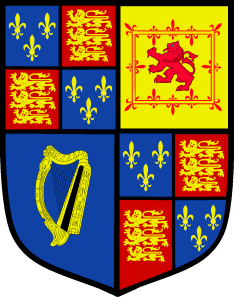|
Evolution of the Royal Arms of England 
James I Born June 19, 1566 Died March 27, 1625 Father: Lord Darnley Mother: Mary Queen of Scots James I -- In 1603, the arms of England and France were placed in the first and fourth quarters, the arms of Scotland ("Or a lion rampant within a double tressure flory counterflory gules") were placed in the second quarter, and the arms of Ireland ("Azure a harp or stringed argent") were placed in the third quarter. (Note: the Irish arms were added only at this time even though the Kings of England had been the Kings of Ireland since 1541.) These arms remained the same for Charles I, Charles II, and James II. James Charles Stuart was born on June 19, 1566 at Edinburg Castle in Scotland. His father, Lord Darnley, was murdered in early 1567 before young James was 1 year old. His mother, Mary Queen of Scots, subsequently ascended to the Scottish throne. Her reign, however was short lived and she was forced to abdicate in favor of her son on July 24, 1567. Little James was crowned King James VI of Scotland five days later at the tender age of 13 months. Reformation leader John Knox preached the sermon at his coronation. James' mother, Mary, was imprisoned in England by her cousin Queen
Elizabeth and 19 years later, in February of 1587, was executed for her
part in the conspiracy to assassinate Queen Elizabeth. King James never
knew his mother.
The king played a masterly political game and kept his kingdom out of war. For the first time a Scottish monarch wielded effective authority over the more far-flung areas of the realm. He supported literature both through his own writing and his patronage. There was peace during his reign--both with his subjects and foreign powers. |

